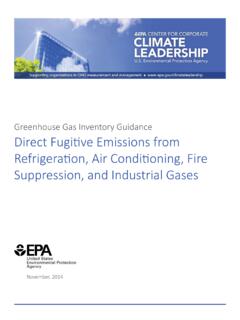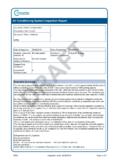Transcription of Part 2 — Systems other than
1 Australia and New Zealand Refrigerant handling code of practice 2007. Part 2 . Systems other than self-contained low charge Systems Prepared by the Australian Institute of Refrigeration, Air Conditioning and Heating (AIRAH). and the Institute of Refrigeration, Heating and Air Conditioning Engineers New Zealand (IRHACE). Part 2 . Systems other than self-contained low charge Systems Prepared by the Australian Institute of Refrigeration, Air Conditioning and Heating (AIRAH). and the Institute of Refrigeration, Heating and Air Conditioning Engineers New Zealand (IRHACE). With funding from the Australian Government Department of the Environment and Water Resources and the New Zealand Climate Change Office Date of publication: September 2007. Australia and New Zealand refrigerant handling code of practice 2007.
2 Table of contents I Acknowledgements_____ 4. II Scope _____ 5. III Referenced documents_____ 5. IV Acronyms for standards and organisations and relevant websites _____ 6. V Definitions_____ 6. VI How to read this code_ _____ 8. 1 General_____ 9. Personnel_____ 9. Refrigerant venting_____ 9. 2 Design _____ 10. Design of mass-manufactured systems_____ 10. General_____ 10. Compressors_____ 11. Refrigerant condensers and evaporators_ _____ 12. Refrigerant pipelines and fittings_____ 13. Valves_ _____ 13. Relief device_ _____ 14. Air purgers (negative pressure Systems )_____ 15. Pump down capability_____ 15. Charge monitors and leak detectors_ _____ 16. 3 Manufacture and assembly_____ 16. General_____ 16. Leak testing_____ 16. Charging of refrigerant_____ 17. 4 Provision of information on installation, use and maintenance_ _____ 17.
3 5 Installation procedures_ _____ 17. 6 Evacuation_____ 20. 2 Australia and New Zealand refrigerant handling code of practice 2007 Part 2 Systems other than self-contained low charge Systems 7 Commissioning_____ 21. 8 Servicing of equipment_____ 22. 9 Cleaning and flushing_ _____ 24. 10 Labelling_____ 25. 11 Maintenance_____ 26. General maintenance_____ 26. Advice to equipment users_____ 27. 12 Retrofitting_____ 28. 13 Decommissioning_ _____ 28. 14 Recovery, recycling and disposal of refrigerants_____ 28. During manufacture, installation and servicing_____ 28. Disposal of refrigerants_____ 30. 15 Handling and storage of refrigerants_ _____ 31. Handling and storage_ _____ 31. Charging_____ 32. Refrigerant transfer between cylinders_____ 32. 16 Appendices_____ 33. Appendix 1 dealing with the recovery of fluorocarbons mixed with other refrigerants_ _____ 33.
4 Appendix 2 fluorocarbon refrigerants _____ 33. Appendix 3 safety group classifications _____ 37. Australia and New Zealand refrigerant handling code of practice 2007 Part 2 Systems other than self-contained low charge Systems 3. I Acknowledgements This Code of Practice was developed with assistance from a review committee and was subject to public comment prior to publication. AIRAH wishes to acknowledge the committee members who have contributed to the preparation of the document, including: Bruce Buchtmann Electrolux Home Products Pty Ltd Ray Clarke ISECO Consulting Services Pty Ltd Don Cleland Massey University, New Zealand Rachael Clarke Department of the Environment and Water Resources (Australia). Craig Duff Active Refrigeration Ltd Greg Groppenbacher Air Conditioning and Refrigeration Equipment Manufacturers Association (Australia).
5 Scott Miller A-Gas Australia Pty Ltd Lindsey Roke Fisher and Paykel Appliances Ltd David Smalldon TAFE Australia Steve Spurling A-Gas Australia Pty Ltd Ben Stapley Department of the Environment and Water Resources (Australia). Christopher Young Department of the Environment and Water Resources (Australia). Editing and drafting by Stuart West and Bonnie Alexander (Australian Institute of Refrigeration, Air Conditioning and Heating).. Commonwealth of Australia 2007. ISBN 978 0 642 55379 3. Information contained in this publication may be copied or reproduced for study, research, information or educational purposes, subject to inclusion of an acknowledgment of the source. The views and opinions expressed in this publication are those of the authors and do not necessarily reflect those of the Australian Government or the Minister for the Environment and Heritage.
6 Neither has this publication been endorsed by the New Zealand Government including the Ministry for the Environment. While reasonable efforts have been made to ensure that the contents of this publication are factually correct, the Commonwealth does not accept responsibility for the accuracy or completeness of the contents, and shall not be liable for any loss or damage that may be occasioned directly or indirectly through the use of, or reliance on, the contents of this publication. 4 Australia and New Zealand refrigerant handling code of practice 2007 Part 2 Systems other than self-contained low charge Systems II Scope This code applies to all refrigeration and air conditioning Systems which use fluorocarbon refrigerants, including heat pumps and transport refrigeration and air conditioning Systems , but excluding: A.
7 Ppliances which contain a fluorocarbon refrigerant charge of two kilograms or less, and do not require any work to be done on the refrigeration system at the time of installation (such Systems are covered by the Australia and New Zealand refrigerant handling code of practice 2007 Part 1 self contained low charge Systems ). This code has been developed with the intention of reducing emissions into the atmosphere of refrigerants listed in Appendix 2, or any other fluorocarbon refrigerant. This code specifies requirements which are mandatory for compliance with the code, and also includes best practice recommendations. Environmental benefits and cost savings from reduced losses can be expected from the application of this code including the use of alternative refrigerants. Systems which do not use a fluorocarbon refrigerant (or do not use a refrigerant blend containing a fluorocarbon) are not covered by this code.
8 III Referenced Documents The following documents are referred to in this code: Document Title AIRAH DA19 HVAC&R Maintenance AS/NZS 1200:2000 Pressure Equipment 1571:1995 Copper - Seamless tubes for air conditioning and refrigeration :1998 Refrigerating Systems . Part 2: Safety Requirements for fixed applications :1998 Performance of electrical appliances air conditioners and heat pumps . test methods non-ducted air conditioners and heat pumps testing and rating for performance AS 1210:1997 Pressure Vessels :2001 Performance of electrical appliances Air conditioners and heat pumps - Test methods - Ducted air conditioners and air-to-air heat pumps - Testing and rating for performance :1999 The verification, filling, inspection, testing and maintenance of cylinders for storage and transport of compressed gases Cylinders for compressed gases other than acetylene 4041:1998 Pressure Piping :1996 Gas recovery on combined recovery and recycling equipment.
9 Part 3: Fluorocarbon refrigerants from commercial/domestic refrigeration and air conditioning Systems 4484:2004 Gas cylinders for industrial, scientific, medical and refrigerant use Labelling and colour coding ANSI/ARI 580-2001 Non-Condensable Gas Purge Equipment for Use with Low Pressure Centrifugal Liquid Chillers ARI 700-2004 Specification for Fluorocarbon Refrigerants ASHRAE Guideline 1-1996 The HVAC Commissioning Process Code M Commissioning - Management Australia and New Zealand refrigerant handling code of practice 2007 Part 2 Systems other than self-contained low charge Systems 5. Australian Act Ozone Protection and Synthetic Greenhouse Gas Management Act 1989 (as amended in 2003). Australian Regulation Ozone Protection and Synthetic Greenhouse Gas Management Regulations 1995. Australia / New Zealand Code of Australia and New Zealand refrigerant handling code of practice Part 2.
10 Practice Systems other than self-contained low charge Systems CIBSE Code C Commissioning Controls New Zealand Act Ozone Layer Protection Act 1996. SAE J51 Refrigerant 12 Automotive Air Conditioning Hose IV Acronyms for Standards and Organisations and Relevant Websites Acronym Standard/Organisation Website AIRAH Australian Institute of Refrigeration Air Conditioning and Heating ANSI American National Standards Institute ARC Australian Refrigeration Council ARI Air-Conditioning and Refrigeration Institute (American) AS Australian Standard DEW Department of Environment and Water Resources (Australia). IRHACE Institute of Refrigeration, Heating and Air Conditioning Engineers New Zealand NZCCO New Zealand Climate Change Office NZS New Zealand Standard RRA Refrigerant Reclaim Australia SAE Society of Automotive Engineers (American) V Definitions For the purp ose of this code the following definitions apply: Alternative refrigerant Alternative refrigerant means a refrigerant other than that for which a system was designed.








